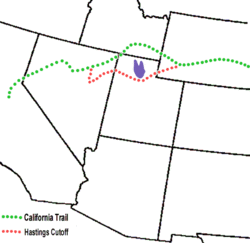Hastings Cutoff facts for kids
Quick facts for kids Hastings Cutoff |
|
|---|---|

Route of the California Trail and Hastings Cutoff in the western United States.
|
|
| Location | Humboldt River Basin, Elko County |
| Official name: West End of Hastings Cutoff | |
| Reference no. | 3 |
The Hastings Cutoff was a different path for pioneers heading west to California. It was suggested by Lansford Hastings in his book, The Emigrant's Guide to Oregon and California. Sadly, the famous Donner Party used this route in 1846 and faced many problems.
Contents
What Was the Hastings Cutoff?
Lansford Hastings wrote a short description of his suggested shortcut. He said that people going to California should leave the main Oregon Trail about 200 miles east of Fort Hall. From there, they should travel southwest to the Great Salt Lake. Then, they would continue to the San Francisco Bay area using a path he had already described.
This cutoff started at Fort Bridger in Wyoming. It went through the Wasatch Mountains, which are very rugged. Then, it crossed the Great Salt Lake Desert, a dry area about 80 miles long with almost no water. After that, it looped around the Ruby Mountains. Finally, it rejoined the main California Trail about seven miles west of where Elko is today. This meeting point was also called Emigrant Pass.
The western end of the cutoff is now marked as Nevada Historical Marker number 3.
Who Used the Hastings Cutoff?
Lansford Hastings himself traveled west in late 1845. He spent the winter in California. While he was at Sutter's Fort, John C. Frémont also visited. Frémont had just explored the Great Salt Lake Desert. His letter describing a new route to California was printed in many newspapers back east.
In April 1846, Hastings left California with a few friends. He wanted to meet the pioneers coming that year. He waited near the Sweetwater River. An eastbound traveler carried a letter from Hastings. It invited pioneers on the California Trail to meet him at Fort Bridger.
Early Travelers on the Cutoff
About 60 to 75 wagons decided to join Hastings. They traveled with him on his new cutoff. They had a tough time going down Weber Canyon. They also faced the 80-mile journey across the Great Salt Lake Desert with no water. Plus, they had a long detour around the Ruby Mountains. Even with these challenges, they made it safely to California.

The Donner Party's Difficult Journey
The Donner Party followed this first group in 1846. Their experience with the Hastings Cutoff was very difficult. They arrived about a week too late to travel with Hastings' group. Hastings suggested they try a different route to avoid Weber Canyon. Building a road through the Wasatch Mountains took a lot of time. The hard journey across the Great Salt Lake Desert also caused delays.
By the time they reached the California Trail, they were about a month behind schedule. The party arrived at Donner Pass just as an early winter storm hit. This made the pass impossible to cross. They became stuck in the snow in the Sierra Nevada. Many people died from extreme starvation.
Mormon Pioneers and Improvements
In July 1847, Mormon leader Brigham Young led a group of pioneers. They traveled from Winter Quarters (in today's Omaha) to the future site of Salt Lake City. This group chose to use the Hastings Cutoff. They passed through what is now Emigration Canyon.
Young's group made great improvements to parts of the cutoff. This made it easier for later Mormon groups to reach the Salt Lake valley. William Clayton, who wrote down the company's journey, noted that they tried to follow the Donner Party's tracks. However, they could only find them sometimes.
When the Cutoff Was Abandoned
The California Gold Rush caused a huge increase in people traveling west. Several groups in 1849 and 1850 used the Hastings Cutoff. But in 1850, a new route called the Salt Lake Cutoff was developed. This new path avoided the Great Salt Lake Desert west of the lake.
After that, the Hastings Cutoff was mostly abandoned. Only the parts east of Salt Lake City were still used. These parts became the end of the Mormon Trail.
See also
- In Spanish: Atajo de Hastings para niños

